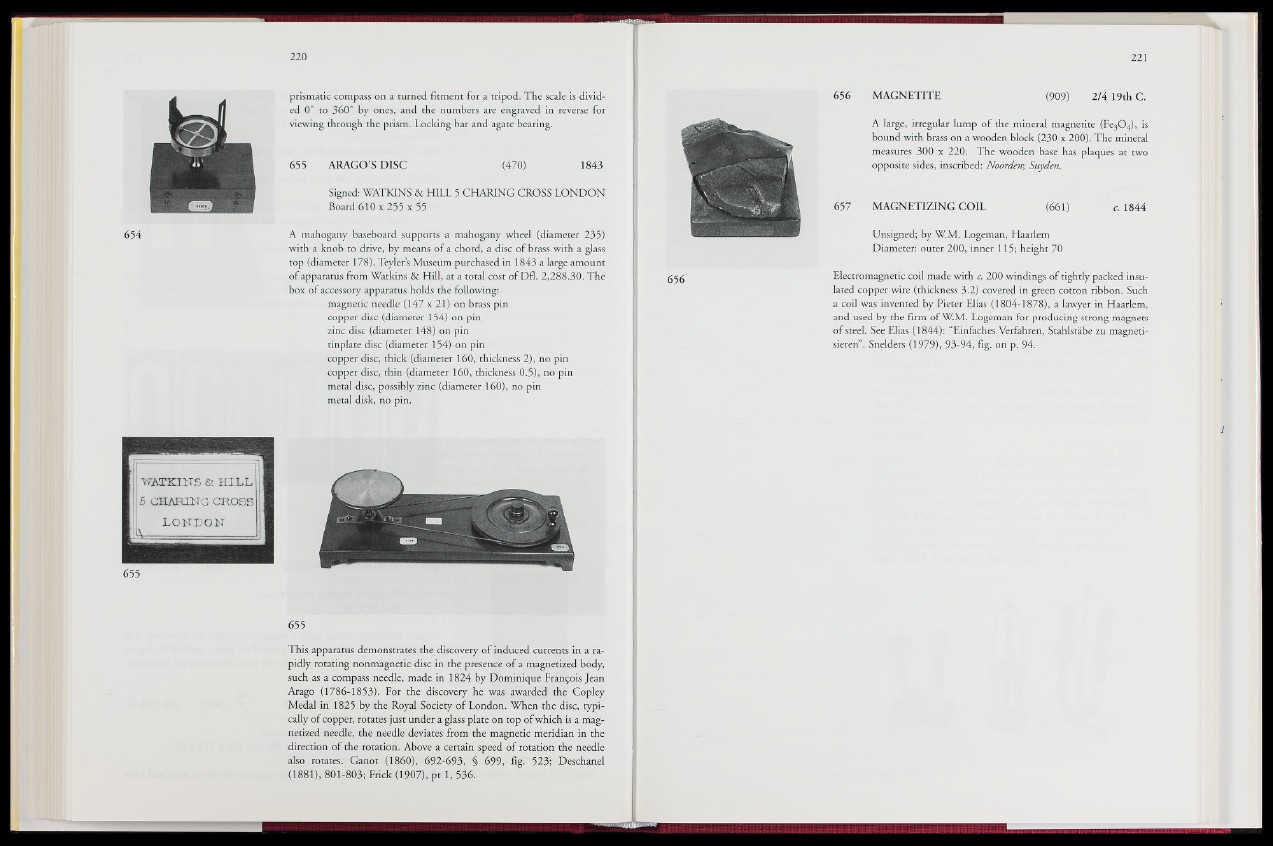
prismatic compass on a turned fitment for a tripod. The scale is divided
0° to 360° by ones, and the numbers are engraved in reverse for
viewing through the prism. Locking bar and agate bearing.
655 ARAGO’S DISC (470) 1843
Signed: WATKINS & HILL 5 CHARING CROSS LONDON
Board 610 x 255 x 55
654 A mahogany baseboard supports a mahogany wheel (diameter 235)
with a knob to drive, by means of a chord, a disc of brass with a glass
top (diameter 178). Teyler’s Museum purchased in 1843 a large amount
of apparatus from Watkins & Hill, at a total cost of Dfl. 2,288.30. The
box of accessory apparatus holds the following:-
magnetic needle (147 x 21) on brass pin
copper disc (diameter 154) on pin
zinc disc (diameter 148) on pin
tinplate disc (diameter 154) on pin
copper disc, thick (diameter 160, thickness 2), no pin
copper disc, thin (diameter 160, thickness 0.5), no pin
metal disc, possibly zinc (diameter 160), no pin
metal disk, no pin.
655
655
This apparatus demonstrates the discovery of induced currents in a rapidly
rotating nonmagnetic disc in the presence of a magnetized body,
such as a compass needle, made in 1824 by Dominique François Jean
Arago (1786-1853). For the discovery he was awarded the Copley
Medal in 1825 by the Royal Society of London. When the Ss'e, typically
of copper, rotates just under a glass plate on top of which is a magnetized
needle, the needle deviates from the magnetic meridian in the
direction of the rotation. Above a certain speed of rotation the needle
also rotates. Ganot (1860), 692-6937 § 699, fig. 523; Deschanel
(1881), 801-803; Frick ( 1 9 0 ||p t 1, 536.
656 MAGNETITE (909) 2/4 19th C.
A large, irregular lump of the mineral magnetite (Fe30 4 ), is
bound with brass on a wooden block (230 x 200). The mineral
measures 300 x 220. The wooden base has plaques at two
opposite sides, inscribed: Noordeir, Süyden.
657 MAGNETIZING COIL (661) c. 1844
Unsigned; by W.M. Logeman, Haarlem
Diameter: outer 200, inner 115; heigh®0
Electromagnetic coil made with c. 200 windings of tighdy packed insu-
tifted copper wire (thickness 3.2) covered in green cotton ribbon. Such
a coil was invented by Pieter Elias (1804-1878), a lawyer in Haarlem,
and used by the firm of W.M. Logeman for producing strong magnets
of steel. See Elias (1841J: “Einfaches Verfahren, Stahlstäbe zu magnetisieren”.
Snelders (1979), 93-94, fig. on p. 94.